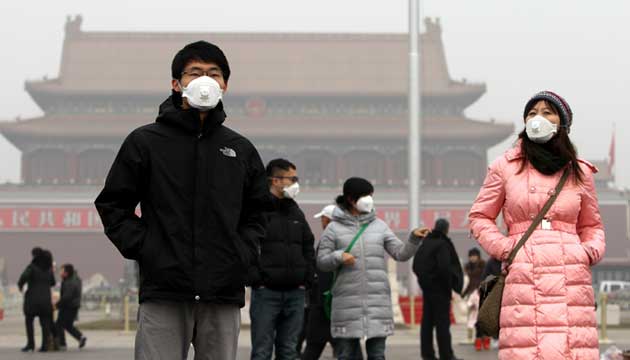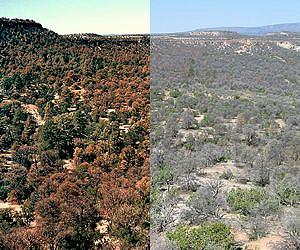
by Deep Green Resistance News Service | Aug 2, 2012 | Biodiversity & Habitat Destruction, Mining & Drilling
By Jeremy Hance / Mongabay
Burning coal fuels climate change, causes acid rain, and spreads toxic pollutants into the environment, but now a new Greenpeace report warns that coal may also imperil the world’s biggest feline: the tiger. Home to world’s largest population of tigers—in this case the Bengal subspecies (Panthera tigris tigris)—India is also the world’s third largest coal producer. The country’s rapacious pursuit of coal—it has nearly doubled production since 2007—has pushed the industry into tiger territory, threatening to destroy forests and fragment the tiger’s already threatened population.
“Unfortunately for the tiger, its largest contiguous habitat—Central India—is also where most of India’s coal lies,” Ashish Fernandes, author of the report, told mongabay.com.
India is one of the bright spots in the global effort to save the tiger from extinction. The country now holds around 1,700 tigers, over half of the world’s population of wild tigers. Although India’s tiger population is generally considered to be in decline, there have been some local population increases giving hope that the country can turn around the situation. Yet the tiger still faces poaching and habitat loss, the latter which is likely to be exacerbated by open pit mining for coal.
“Several of India’s largest coalfields (such as Singrauli and Talcher) include forest areas adjoining Tiger Reserves, and where tigers are found. Coal mines are already eating into these areas, and with the ongoing expansion, this will worsen,” Fernandes says.The Bengal tiger, which is considered Endangered by the IUCN Red List, is the undisputed king in these forests, which in some cases also sports populations of leopard (Panthera pardus), Near Threatened; Asian elephant (Elephas maximus), Endangered; sloth bear, (Melursus ursinus), Vulnerable; sambar (Rusa unicolor), Vulnerable; and other non-threatened deer and antelope species.
Analyzes 13 Central Indian coal mines, in various stages of exploitation, the report finds that full open pit mining in these areas would destroy over a million hectares of forest. According to official data, 18 percent of these forests are known to be used by tigers, 27 percent by leopards, and 5.5 percent by elephants. In all, eight of India’s renowned Tiger Reserves will be impacted, potentially harming around 230 tigers or 13 percent of India’s total tiger population.
“India’s Protected Areas/Tiger Reserves are small by global standards, with few larger than 500 square kilometers. As such, if isolated, their tiger populations are not viable in the long term,” Fernandes explains. “Tigers, males in particular, roam large areas in search of mates, and this ensures genetic vibrancy. As young tigers mature, they also need to establish their own territories, or face conflict with dominant males. Corridors help aid this dispersal and ensure a healthy gene flow between different ‘source’ tiger populations.”
India is a signatory of an ambitious conservation plan to double wild tiger populations worldwide by 2022, a plan which was endorsed by all 13 tiger countries in 2010. Worldwide, tigers have been decimated by habitat loss, prey depletion, and hunting, now largely to feed the Chinese medicine trade. The great cats have been left with about 7 percent of their historical range, and already three subspecies have vanished for good.

by Deep Green Resistance News Service | Aug 1, 2012 | Toxification
By European Geosciences Union
Most of the world’s population will be subject to degraded air quality in 2050 if man-made emissions continue as usual. In this ‘business-as-usual’ scenario, the average world citizen 40 years from now will experience similar air pollution to that of today’s average East Asian citizen. These conclusions are those of a study published today in Atmospheric Chemistry and Physics, an Open Access journal of the European Geosciences Union (EGU).
Air pollution is a major health risk that may worsen with increasing industrial activity. At present, urban outdoor air pollution causes 1.3 million estimated deaths per year worldwide, according to the World Health Organisation.
“Strong actions and further effective legislation are essential to avoid the drastic deterioration of air quality, which can have severe effects on human health,” concludes the team of scientists, led by Andrea Pozzer of the Abdus Salam International Centre for Theoretical Physics in Italy (now at the Max Planck Institute of Chemistry in Germany), in the new paper.
The researchers studied the impact of man-made emissions on air quality, assuming past emission trends continue and no additional climate change and air pollution reduction measures (beyond what is in place since 2005) are implemented. They point out that, while pessimistic, the global emissions trends indicate such continuation.
“At present the post-Kyoto climate negotiations are progressing slowly, and it is unclear how air quality policies will develop globally,” explains co-author Greet Janssens-Maenhout of the European Commission Joint Research Centre in Italy. “In regions with economic growth, it might be less effective to implement emission-reduction measures due to strong growth in activities in particular sectors; in countries suffering from the economic downturn, implementing expensive air-quality measures could prove difficult in coming years,” she adds.
“We show that further legislation to control and reduce man-made emissions is needed, in particular for eastern China and northern India, to avoid hot-spots of elevated air pollution,” says Pozzer. Combined with the fact that these are regions of high population density, elevated air pollution here would mean that air quality would worsen significantly for the average world citizen in 2050.
Air pollution would also increase in Europe and North America, but to a much lesser extent than in Asia, due to the effect of mitigation policies that have been in place for over two decades.
Pozzer and his colleagues estimated air quality in 2005, 2010, 2025 and 2050 using an atmospheric chemistry model. “The model uses basic mathematical formulation to predict the meteorology and the chemical composition of the atmosphere,” Pozzer explains. “In practice, it is a software used to forecast – or hindcast, for past years – the status of the atmosphere at specific times.”
The results show that in 2025 and 2050, under the business-as-usual scenario studied, East Asia will be exposed to high levels of pollutants, such as nitrogen dioxide, sulphur dioxide and fine particulate matter (PM2.5). Northern India and the Arabian Gulf region, on the other hand, will suffer a marked increase in ozone levels.
The analysis now published is the first to include all five major air pollutants know to negatively impact human health: PM2.5, nitrogen dioxide, sulphur dioxide, ozone, and carbon monoxide. The scientists considered pollutants released through human activity, as well as those occurring naturally such as desert dust, sea spray, or volcanic emissions.
Taking all pollutants into account, eastern China, northern India, the Middle East, and North Africa are projected to have the world’s poorest air quality in the future. In the latter locations this is due to a combination of natural desert dust and man-induced ozone. The effect of anthropogenic pollution emissions are predicted to be most harmful in East and South Asia, where air pollution is projected to triple compared to current levels.
The study aimed to compare the influence of man-made emissions on air quality in different regions, and show how no-further legislation to reduce emissions can result in drastic deterioration of air quality worldwide compared to the present day situation.
From European Geosciences Union: http://www.egu.eu/news/36/cut-emissions-further-or-face-risks-of-high-air-pollution-study-shows/

by Deep Green Resistance News Service | Jul 31, 2012 | ACTION, Mining & Drilling, Protests & Symbolic Acts, Toxification
By Peter Rugh / Waging Nonviolence
The war came home this weekend, as thousands of people whose land has been under siege by the U.S. government and corporate interests gathered in Washington, D.C. No, they weren’t victims of drone attacks or 10-plus years of fighting in Afghanistan. They were ordinary Americans, whose neighborhoods, townships and states have been struggling to put an end to fracking, a destructive form of natural gas drilling.
These veterans of the frack war were in Washington for a national convergence called Stop the Frack Attack. Over the course of two days, they held teach-ins and strategy sessions on ways to bring relief to their communities through collective action, before ending on Saturday with the first ever national march and rally against fracking. Many hailed the event as an important step to building a broad, grassroots movement to ban the drilling practice.
“I’m going to dream big,” said Jennie Scheibach with NonToxic Ohio, a group fighting the spread of fracking in northern Ohio and the disposal of fracking waste in the state’s rivers. “Standing together, rising up together, we can stop this.”
Jennie wasn’t alone. Thousands of people from across the country, from voluminous backgrounds, joined in common cause in D.C. over the weekend, raising the call for an end to fracking.
Lori New Breast of the Blackfoot Nation, whose homeland encompasses parts of Montana, Alberta, and Saskatchewan, took part in the rally. She said her community is mobilizing to reject fracking. “Oil companies would like you to think that that land is unoccupied and that we are gone. But as the care takers of the headwaters of the continent, we are still here. We do not want fracking. It is a threat to our cultural way of life.”
Members of Occupy Wall Street Environmental Solidarity were also on hand in D.C. as well, carrying banners that read, “Safe Fracking is a Lie; Occupy! Resist!” and “Frack Wall Street, Not Our Water!”
Meanwhile, suburban mothers like Vicky Bastidas, who brought her three teenage daughters to the rally, were present. She and her family have been fighting frackers from drilling near schools and playgrounds in their home town of Bethlehem, Pennsylvania. Vicky said she was heartened by a recent court decision that overturned a law barring local municipalities from banning fracking and now looks forward to passing a ban in her town.
The decision might have come too late to reverse much of the long-term damage that the unimpeded invasion of drilling has done to Pennsylvania, but nonetheless it grants Pennsylvanians a chance to set up legal barricades against the fracking bombardment. Bastidas had a message from her family to Governor Corbett and lawmakers like him: “Our water is not for sale. We can live without oil. We can live without gas. But we cannot live without water.”
This was a widespread sentiment among the approximately 4,000 demonstrators who marched from the Capitol building to the headquarters of the American Petroleum Institute (API), the oil and gas industry’s lobbying arm. Along the way they made a brief stop at the home base of the American Natural Gas Alliance (ANGA), where Delaware Riverkeeper Maya Van Rossum held up a murky, brown libation of chemical diarrhea in a clear plastic jug.
“This is frack water,” she said. “We don’t want it in our communities. We can’t drink it safely. We’re giving it back to the drillers. I bet they won’t drink it!” Uniformed in hazmat suits, Van Rossum and several of her colleagues with Delaware Riverkeeper chanted “shame” and pounded on ANGA’s doors, but a representative of the Alliance failed to appear for a taste test.
Next, demonstrators flooded the courtyard of API’s home office. “The water, the water, the water is on fire,” they hollered in unison, “We don’t need no fracking let the corporations burn.” Members of the crowd set down a 10-foot replica of a fracking rig made of bamboo and canvas at API’s door and tipped it over. The move was a symbolic representation of what they hope the burgeoning movement against fracking can accomplish nationally.
The action also pointed toward another tipping point, that of the climate, which has been driven to the brink of near collapse by the fossil fuel industry with the support of politicians, including President Barack Obama, who received $884,000 in campaign donations from the oil and gas industry in 2008. Given such a payout, it should not be surprising that Obama signed a little-noticed executive order earlier this year establishing an intergovernmental task force for the support of “unconventional” gas drilling — in other words fracking.
With the stroke of a pen, Obama picked a side in a war that began under his predecessor’s administration. In 2005, lawmakers on Capitol Hill approved the Energy Policy Act, a bill championed by then-Vice President and former Halliburton executive Dick Cheney that exempted frackers from the Safe Drinking Water Act (SDWA) and the Clean Water Act (CWA). The fracking amendments gave the world’s wealthiest energy corporations license to invade some of America’s poorest counties, poison their drinking water, foul their air and putrefy their soil. For each frack site, and there are now tens of thousands across America, drillers pump millions of gallons of water, sand and toxic chemicals into the land in order to draw oil and gas from shale rock.
Since the frack boom began, impoverished, cloistered communities sitting on millions of dollars worth of shale gas — from Pennsylvania to Wyoming, from indigenous tribal lands in Montana to the Texas border — have become ground zeros for fracking. In most cases, they are offered a short-term cash prize for land rights or desperately needed jobs in return for long-term ecological devastation. Such a strategy for prosperity, critics contend, would have left mountaintop removal strongholds in Appalachia looking like Beverly Hills long ago.
Instead, it seems the only pockets being lined are those of the corporate executives and politicians. In 2010, the fracking industry raked in $76 billion in revenues. Meanwhile, the Obama 2012 campaign is set to bring in more from oil and gas lobbyists than was raised in the previous election. If there’s hope in matching corporate campaign donations, though, it’s not with money, but rather a national movement, comprised of the diverse voices of dissent that marched through Washington on Saturday.
by Deep Green Resistance News Service | Jul 31, 2012 | Mining & Drilling, Toxification
By Duke University
Water pollution from surface coal mining has degraded more than 22 percent of streams and rivers in southern West Virginia to the point they may now qualify as impaired under state criteria, according to a new study by scientists at Duke and Baylor universities.
The study, published this week in the peer-reviewed journal Environmental Science & Technology, documents substantial losses in aquatic insect biodiversity and increases in salinity linked to sulfates and other pollutants in runoff from mines often located miles upstream.
“Our findings offer concrete evidence of the cumulative impacts surface mining is having on a regional scale,” said Emily S. Bernhardt, associate professor of biogeochemistry at Duke’s Nicholas School of the Environment. “The relationship is clear and direct: The more mining you have upstream, the higher the biological loss and salinity levels will be downstream, and the farther they will extend.”
Numerous recent studies have demonstrated the water-quality problems caused at or near the site of individual surface coal mines, Bernhardt noted. So she and her team “set out to understand how the large and growing number of surface mines is affecting water quality throughout Appalachia.”
They used NASA satellite images and computer data to map the extent of surface mining taking place across a 12,000-square-mile area of the southern West Virginia coalfields between 1976 and 2005.
They found that companies had converted more than 5 percent of the land into mine sites and buried 480 miles of streams beneath adjacent valley fills during this period.
By overlaying the map with chemical and biological data from 223 streams the West Virginia Department of Environmental Protection sampled in the study area between 1997 and 2007, the researchers determined that pollution runoff from the mines could substantially degrade more than 1,400 miles of streams in the region – four times the length of streams buried below the valley fills.
“It’s important to recognize that surface coal mining pollution doesn’t stop at mine-permit boundaries,” said Brian D. Lutz, a postdoctoral associate in Bernhardt’s lab.
“Our analysis suggests that mining only 5 percent of the land surface is degrading between 22 percent and 32 percent of the region’s rivers,” he said.
Substantial declines in insect diversity began to occur when companies had mined as little as 1 percent of upstream land, the analysis showed. In areas where companies had converted about 5 percent of the land into mines, sensitive species such as mayflies and stoneflies had vanished or declined to an extent that the streams would qualify as biologically impaired under criteria set by the state of West Virginia.
The designation means the streams could be placed on a list of waterways that the state must take steps to rehabilitate.
“What is so compelling is that we found many different types of organisms are lost downstream of surface coal mines, and most of them begin to disappear at similar levels of mining,” said Ryan S. King, associate professor of biology at Baylor. “Our analysis shows that coal mining is leading to widespread declines in aquatic biodiversity in Appalachian streams.”
Lutz and King co-authored the paper with Bernhardt. Other coauthors were John P. Fay, instructor of geospatial analysis at the Nicholas School; Catherine E. Carter, a 2010 master’s graduate of the Nicholas School, now at TetraTech; Ashley M. Helton, postdoctoral associate in Duke’s Department of Biology; John Amos of SkyTruth; and David Campagna, of Campagna & Associates.
The study was supported by unrestricted gifts in support of research from The Foundation for the Carolinas and the Sierra Club, and through a contract to Amos and Campagna from Appalachian Voices.
From Duke University

by Deep Green Resistance News Service | Jul 30, 2012 | Climate Change
By Oregon State University News
The chronic drought that hit western North America from 2000 to 2004 left dying forests and depleted river basins in its wake and was the strongest in 800 years, scientists have concluded, but they say those conditions will become the “new normal” for most of the coming century.
Such climatic extremes have increased as a result of global warming, a group of 10 researchers reported today in Nature Geoscience. And as bad as conditions were during the 2000-04 drought, they may eventually be seen as the good old days.
Climate models and precipitation projections indicate this period will actually be closer to the “wet end” of a drier hydroclimate during the last half of the 21st century, scientists said.
Aside from its impact on forests, crops, rivers and water tables, the drought also cut carbon sequestration by an average of 51 percent in a massive region of the western United States, Canada and Mexico, although some areas were hit much harder than others. As vegetation withered, this released more carbon dioxide into the atmosphere, with the effect of amplifying global warming.
“Climatic extremes such as this will cause more large-scale droughts and forest mortality, and the ability of vegetation to sequester carbon is going to decline,” said Beverly Law, a co-author of the study, professor of global change biology and terrestrial systems science at Oregon State University, and former science director of AmeriFlux, an ecosystem observation network.
“During this drought, carbon sequestration from this region was reduced by half,” Law said. “That’s a huge drop. And if global carbon emissions don’t come down, the future will be even worse.”
This research was supported by the National Science Foundation, NASA, U.S. Department of Energy, and other agencies. The lead author was Christopher Schwalm at Northern Arizona University. Other collaborators were from the University of Colorado, University of California at Berkeley, University of British Columbia, San Diego State University, and other institutions.
It’s not clear whether or not the current drought in the Midwest, now being called one of the worst since the Dust Bowl, is related to these same forces, Law said. This study did not address that, and there are some climate mechanisms in western North America that affect that region more than other parts of the country.
But in the West, this multi-year drought was unlike anything seen in many centuries, based on tree ring data. The last two periods with drought events of similar severity were in the Middle Ages, from 977-981 and 1146-1151. The 2000-04 drought affected precipitation, soil moisture, river levels, crops, forests and grasslands.
Ordinarily, Law said, the land sink in North America is able to sequester the equivalent of about 30 percent of the carbon emitted into the atmosphere by the use of fossil fuels in the same region. However, based on projected changes in precipitation and drought severity, scientists said that this carbon sink, at least in western North America, could disappear by the end of the century.
“Areas that are already dry in the West are expected to get drier,” Law said. “We expect more extremes. And it’s these extreme periods that can really cause ecosystem damage, lead to climate-induced mortality of forests, and may cause some areas to convert from forest into shrublands or grassland.”
During the 2000-04 drought, runoff in the upper Colorado River basin was cut in half. Crop productivity in much of the West fell 5 percent. The productivity of forests and grasslands declined, along with snowpacks. Evapotranspiration decreased the most in evergreen needleleaf forests, about 33 percent.
The effects are driven by human-caused increases in temperature, with associated lower soil moisture and decreased runoff in all major water basins of the western U.S., researchers said in the study.
Although regional precipitations patterns are difficult to forecast, researchers in this report said that climate models are underestimating the extent and severity of drought, compared to actual observations. They say the situation will continue to worsen, and that 80 of the 95 years from 2006 to 2100 will have precipitation levels as low as, or lower than, this “turn of the century” drought from 2000-04.
“Towards the latter half of the 21st century the precipitation regime associated with the turn of the century drought will represent an outlier of extreme wetness,” the scientists wrote in this study.
These long-term trends are consistent with a 21st century “megadrought,” they said.
From Oregon State University: http://oregonstate.edu/ua/ncs/archives/2012/jul/chronic-2000-04-drought-worst-800-years-may-be-%E2%80%9Cnew-normal%E2%80%9D




